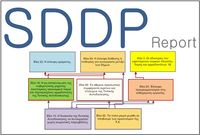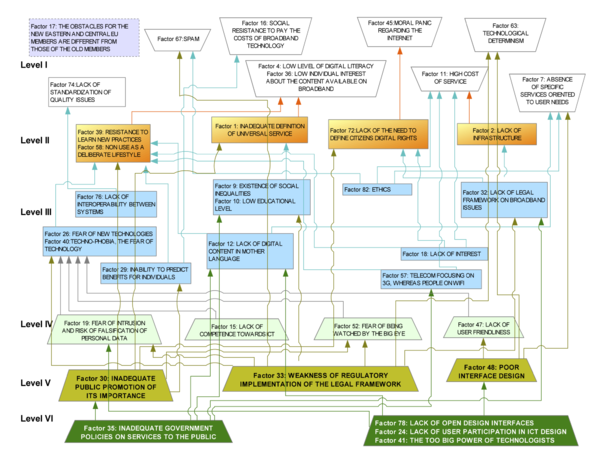SDDP COST 298 Participation in the Broadband society: Difference between revisions
No edit summary |
No edit summary |
||
| (11 intermediate revisions by 4 users not shown) | |||
| Line 1: | Line 1: | ||
{{SDD_Report | {{SDD_Report | ||
|acronym=SDDP Obstacles to practical broadband applications | |acronym= SDDP Obstacles to practical broadband applications | ||
|book_image= SDDP_Report_Image.jpg | |book_image= SDDP_Report_Image.jpg | ||
|report_title=A systemic evaluation of obstacles that prevent the development of practical applications | |report_title= A systemic evaluation of obstacles that prevent the development of practical applications | ||
|Triggering_Question=Considering the availability of powerful broadband technologies and the development of relevant scenarios, what are the obstacles that prevent us from producing practical applications? | |project= [[COST 298: Participation in the Broadband society|COST 298]] | ||
| | |Triggering_Question= Considering the availability of powerful broadband technologies and the development of relevant scenarios, what are the obstacles that prevent us from producing practical applications? | ||
|author=[[Yiannis Laouris]] | |location= Larnaca, Cyprus | ||
|editor= [[Yiannis Laouris]] <br> [[Marios Michaelides]] <br> [[Bartolomeo Sapio]] | |dates= 2006 | ||
|total_duration=2 days | |LeadFacilitator= | ||
|stats=Participants= | |AsFacilitator= | ||
| | |author= [[Yiannis Laouris]] | ||
|link=[[Media:Laouris_et_al_Cost298Book_InnovatorsCh14_only.pdf|Download Report] | |editor= [[Yiannis Laouris]] <br> [[Marios Michaelides]] <br> [[Bartolomeo Sapio]] | ||
|total_duration= 2 days | |||
|stats= Participants=26 <br> Number of ideas=82 <br>Number of Clusters=12 <br> Ideas received Votes=50 <br> Ideas on MAP R=35 <br>Spreadthink ST=58% | |||
|isbn= | |||
|link= [[Media:Laouris_et_al_Cost298Book_InnovatorsCh14_only.pdf|Download Report]] | |||
}} | }} | ||
==Executive Summary== | ==Executive Summary== | ||
This report has been developed in the context of the [[COST | This report has been developed in the context of the [[COST 298: Participation in the Broadband society|COST 298]] project. The goal of the project is to create a platform that can bring together the various stakeholders in the area of accessible and assistive ICT with a view to identifying Research & Development gaps and emerging trends and generating a research agenda roadmap. The results presented here stem from a co-laboratory, which took place in Larnaca, Cyprus on the 29th (4 hours) and 30th (4 hours) of September 2006. A total of 26 experts produced 82 factors in response to the triggering question. | ||
<u>The [[Triggering Question]] (TQ) was </u><br> | <u>The [[Triggering Question]] (TQ) was </u><br> | ||
''' | '''What are the obstacles to the wider public benefiting from and participating in the broadband society?''' | ||
In response to the TQ, the 26 participants came up with 82 obstacles, which were categorized in 12 clusters. | |||
Following the voting process, 37 ideas received one or more votes and were structured to create the influence MAP shown below. <br> | |||
The experts in the COST 298 community perceived factors 4, 9, 18, 7, and 26 as the most significant. During the voting process, these factors received 12, 9, 9, 8, and 7 votes respectively. | |||
<br> | <br> | ||
[[ | [[File: COST298_SDDP_MAP.png|thumb|center|upright=2.0|alt=MAP for COST 298 Obstacles|Influence tree on the obstacles that prevent the development of practical applications]] | ||
<br> | <br> | ||
The participants had time to discuss and reflect on the influence map and in general agreed that the arrows in the map made sense to them. In sum, the participants reported their satisfaction that their voices have been heard and documented and communicated their expectations for follow-up activities to address the diagnosis of their needs.<br> <br> | The participants had time to discuss and reflect on the influence map and in general agreed that the arrows in the map made sense to them. In sum, the participants reported their satisfaction that their voices have been heard and documented and communicated their expectations for follow-up activities to address the diagnosis of their needs.<br> <br> | ||
The workshop was facilitated by [[Yiannis Laouris]] ([[Cyprus Neuroscience and Technology Institute |CNTI]]), [[Bartolomeo Sapio]]. | |||
[[Category:Future Worlds Center Projects]] | [[Category:Future Worlds Center Projects]] | ||
| Line 45: | Line 48: | ||
[[Category:SDDP (Society)]] | [[Category:SDDP (Society)]] | ||
[[Category:SDDP (Technology)]] | [[Category:SDDP (Technology)]] | ||
[[Category: SDDP Reports]] | |||
Latest revision as of 09:23, 9 December 2023
|
Executive Summary
This report has been developed in the context of the COST 298 project. The goal of the project is to create a platform that can bring together the various stakeholders in the area of accessible and assistive ICT with a view to identifying Research & Development gaps and emerging trends and generating a research agenda roadmap. The results presented here stem from a co-laboratory, which took place in Larnaca, Cyprus on the 29th (4 hours) and 30th (4 hours) of September 2006. A total of 26 experts produced 82 factors in response to the triggering question.
The Triggering Question (TQ) was
What are the obstacles to the wider public benefiting from and participating in the broadband society?
In response to the TQ, the 26 participants came up with 82 obstacles, which were categorized in 12 clusters.
Following the voting process, 37 ideas received one or more votes and were structured to create the influence MAP shown below.
The experts in the COST 298 community perceived factors 4, 9, 18, 7, and 26 as the most significant. During the voting process, these factors received 12, 9, 9, 8, and 7 votes respectively.
The participants had time to discuss and reflect on the influence map and in general agreed that the arrows in the map made sense to them. In sum, the participants reported their satisfaction that their voices have been heard and documented and communicated their expectations for follow-up activities to address the diagnosis of their needs.
The workshop was facilitated by Yiannis Laouris (CNTI), Bartolomeo Sapio.

